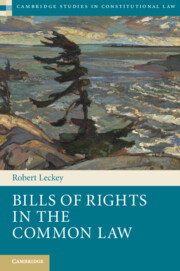Book contents
- Frontmatter
- Dedication
- Contents
- Acknowledgements
- Table of cases
- Introduction
- 1 Against bill-of-rights exceptionalism
- 2 The common law, judging, and three bills of rights
- 3 Judicial review of legislation before bills of rights
- 4 Bills of rights and other means of accessing judgment
- 5 Putting the strike-down in its place
- 6 Remedies from text to practice
- 7 Improving the system and engaging the legislature
- 8 Rethinking remedies and constitutional supremacy
- Conclusion
- Bibliography
- Index
7 - Improving the system and engaging the legislature
Published online by Cambridge University Press: 05 May 2015
- Frontmatter
- Dedication
- Contents
- Acknowledgements
- Table of cases
- Introduction
- 1 Against bill-of-rights exceptionalism
- 2 The common law, judging, and three bills of rights
- 3 Judicial review of legislation before bills of rights
- 4 Bills of rights and other means of accessing judgment
- 5 Putting the strike-down in its place
- 6 Remedies from text to practice
- 7 Improving the system and engaging the legislature
- 8 Rethinking remedies and constitutional supremacy
- Conclusion
- Bibliography
- Index
Summary
Synthesizing the preceding two chapters' accounts, and further drawing out the ideas underlying what judges do and what they say, this chapter characterizes judicial review in the three jurisdictions. It identifies the emergence of two concerns as primary: improving broad-scale government activity and facilitating parliamentary engagement with rights. In contrast, remedying the wrong alleged by individual litigants and giving direct effect to constitutional rights appear secondary. Consistent with this book's attention to difference and its scepticism about convergence in comparative constitutional research, the chapter does not press the data from all three countries into a convergentist mould. It neither celebrates the convergence it detects nor effaces national differences in rights instrument and judicial practice.
This analysis is significant as many discussions, especially theoretical ones, accentuate the individual bearer of rights and the court's task in upholding constitutionalism, which here fall to second rank. In addition, the tendencies discerned in the evidence of practice may be surprising. For example, the analysis draws out that the Canadian and South African courts, equipped with the ‘strong’ power to enforce constitutionalism by declaring legislation immediately and retrospectively invalid, under-use that power with a view to engaging the legislature. It also indicates that practice under the UK's Human Rights Act – often read as relatively ‘weak’, affirming parliamentary sovereignty and enabling legislative engagement – performs relatively robust constitutional enforcement. These analytical findings have weighty normative implications, and one might evaluate them from a number of angles. Depending on one's theoretical predisposition, one might urge courts to press further or to adjust course as they keep applying these bills of rights. Although this book's conclusion will gesture towards paths for such evaluation and prescription, the present aim is chiefly to advance understanding of how bills of rights are playing out.
- Type
- Chapter
- Information
- Bills of Rights in the Common Law , pp. 151 - 169Publisher: Cambridge University PressPrint publication year: 2015



